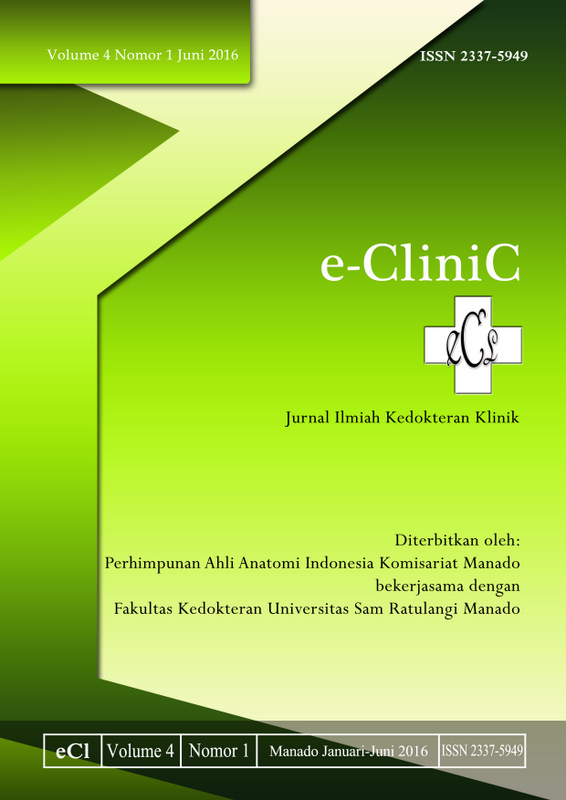Perbandingan NIHSS pada pasien stroke hemoragik dan non-hemoragik yang rawat inap di Bagian Neurologi RSUP Prof. Dr. R. D. Kandou Manado
DOI:
https://doi.org/10.35790/ecl.v4i1.12111Abstract
Abstract: Stroke is a syndrom identified with fast growing symptoms and clinical signs in the form of focal or global disturbance of brain function in more than 24 hours. The clinical signs are carotid blood vessel disturbance (including disturbance of sensation ability on face and mouth, hemiparesis/hemiplegia, and unconsciousness); and vertebrobasilaris blood vessel disturbance (including lack of balance, vertigo, hypotonia on both legs, and swallowing and vomitting problems). National Institute of Health Stroke Scale is a systematic assessment tool that measures the quantity of stroke related to neurological deficit by using 15 assessment items. This study aimed to find out the comparison of neurological deficit between hemorrhagic and non- hemorrhagic stroke inpatients at the Neurology Department of Prof. Dr. R.D. Kandou Hospital Manado. The results showed that mild neurological deficit was found in 38.9% of hemorrhagic stroke patients and in 11.8% of non-hemorhagic stroke patients. Moderate neurological deficit was found found in 33.3% of hemorrhagic stroke patients and 35.3% of non-hemorhagic stroke patients. Meanwhile, neurological deficit was found in 27.8% of hemorrhagic stroke patients and 52.9% of non-hemorhagic stroke patients. Conclusion: NIHSS of mild neurological deficit in hemorrhagic stroke patients was higher than in non-hemorrhagic stroke patients, meanwhile, of moderate deficit both groups were the same, and of severe neurological deficit the NIHSS was higher in non-hemorrhagic stroke patients.
Keywords: NIHSS, stroke, hemorrhagic stroke, non-hemorrhagic stroke.
Â
Abstrak: Stroke adalah suatu sindrom yang ditandai dengan gejala atau tanda klinis yang berkembang cepat berupa gangguan fungsional otak fokal maupun global yang berlangsung lebih dari 24 jam. Pada stroke terdapat gejala klinis terdiri dari gangguan pembuluh darah karotis yaitu gangguan rasa di daerah muka, mulut, hemiparesis/hemiplegi, dan tidak sadar. Gangguan pembuluh darah vertebrobasilaris yaitu kehilangan keseimbangan, vertigo, kedua kaki hipotoni, gangguan menelan, dan muntah. National Institute of Health Stroke Scale adalah alat penilaian sistematik yang mengukur kuantitatif stroke yang terkait dengan defisit neurologik, terdiri dari 15 item pemeriksaan. Penelitian ini bertujuan untuk mengetahui perbandingan defisit neurologik antara stroke hemoragik dan non hemoragik pada pasien yang dirawat inap di bagian Neurologi RSUP Prof. Dr. R.D Kandou Manado. Jenis penelitian ini deskriptif prospektif. Subjek penelitian yaitu pasien yang menderita stroke di bangsal Neurologi RSUP Prof Dr. R.D Kandou Manado periode Januari 2013. Hasil penelitian menunjukan bahwa defisit neurologis ringan pada stroke hemoragik sebesar 38,9% dan pada stroke non hemoragik sebesar 11,8%; defisit neurologis sedang pada stroke hemoragik sebesar 33,3% dan pada stroke non hemoragik sebesar 35,3%; defisit neurologis berat pada stroke hemoragik sebesar 27,8% dan pada stroke non-hemoragik sebesar 52,9%. Simpulan: Pemeriksaan NIHSS untuk derajat neurologis ringan penderita stroke hemoragik lebih banyak daripada penderita stroke non hemoragik; untuk derajat neurologis sedang sama banyak dan untuk derajat neurologis berat penderita stroke non hemoragik lebih banyak.
Kata kunci: NIHSS, stroke, stroke hemoragik, stroke non hemoragik
Downloads
Published
How to Cite
Issue
Section
License
COPYRIGHT
Authors who publish with this journal agree to the following terms:
Authors hold their copyright and grant this journal the privilege of first publication, with the work simultaneously licensed under a Creative Commons Attribution License that permits others to impart the work with an acknowledgment of the work's origin and initial publication by this journal.
Authors can enter into separate or additional contractual arrangements for the non-exclusive distribution of the journal's published version of the work (for example, post it to an institutional repository or publish it in a book), with an acknowledgment of its underlying publication in this journal.
Authors are permitted and encouraged to post their work online (for example, in institutional repositories or on their website) as it can lead to productive exchanges, as well as earlier and greater citation of the published work (See The Effect of Open Access).







